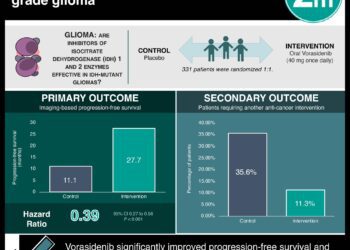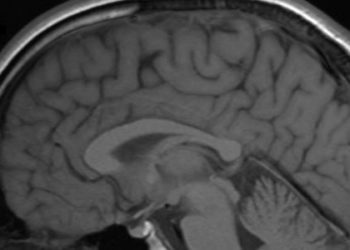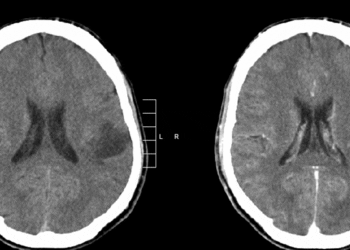Integrative genomic analysis promising for diagnostic subtyping of lower-grade glioma
1. Analysis of genomewide data revealed three robust, nonoverlapping, and clinically significant tumor classes based on presence of IDH mutation and 1p/19q codeletion; these classes were concordant with relevant biomarkers and survival outcomes.
2. Patients with tumors containing IDH mutation and 1p/19q codeletion had the most favorable survival outcomes, in contrast to patients with tumors that were wildtype for IDH, who had the least favorable outcomes and genetic alterations associated with the development of glioblastoma.
Evidence Rating Level: 2 (Good)
Study Rundown: The diagnosis and treatment of lower-grade gliomas (including astrocytomas, oligodendrogliomas, and oligoastrocytomas of WHO grade II and III gliomas) are greatly hampered by high intraobserver and interobserver variability in histopathological classification, which also fails to adequately predict clinical outcomes. In this study, tumor samples of lower-grade gliomas from 293 previously untreated adults were subjected to genomewide analyses including exome sequencing, DNA copy number, DNA methylation status, messenger RNA expression, and targeted protein expression. In an unsupervised clustering analysis of these multidimensional data, three nonoverlapping and prognostically significant genomic subtypes of lower-grade gliomas were identified: tumors with IDH mutations and either 1p/19q codeletion presence of absence, and tumors with IDH wildtype. These genetic status subtypes were more reflective of disease subtypes than histologic class. Lower-grade gliomas with IDH mutation and a 1p/19q codeletion were associated with favorable outcomes; tumors with wildtype IDH had genetic alterations more commonly associated with glioblastoma (WHO grade IV gliomas).
This study is significant in illustrating the potential contribution of integrated genomewide data in the clinical and prognostic workup of lower-grade gliomas and has major implications for the diagnosis and treatment of this disease; however, the data sets will be rendered more robust by a longer follow-up period in the survival analysis of the cohort.
Click to read the study in NEJM
Click to read an accompanying editorial in NEJM
Relevant Reading: Advances in the molecular genetics of glioma classification
In-Depth [retrospective cohort]: This study involved a comprehensive, integrative genomic analysis of diffuse lower-grade gliomas from 293 previously untreated adults (excluding pediatric cases, which have a distinct genetic profile) and relied on a combination of exome sequencing, DNA copy number, DNA methylation status, messenger RNA expression, and targeted protein expression (complete data available across 254 samples). The tumors included 100 astrocytomas, 77 oligoastrocytomas, and 116 oligodendrogliomas. The primary method of integration was a cluster of clusters analysis or a so-called unsupervised analysis, which compiled clusters of tumors with shared molecular profiles across the abovementioned platforms. They found that the concordance between IDH-1p/19q status (currently used in clinical practice for diagnosis and treatment) and the cluster of clusters analysis was greater than between IDH-1p/19q status and histologic subtype (an area of great intraobserver and interobserver variability), with an adjusted Rand index of 0.79 vs. 0.19, respectively. From this they concluded that genetic status was more reflective of disease status than histologic class. Patients with an IDH mutation and 1p/19q codeletion had the longest overall survival, whereas patients with IDH wildtype had the least favorable survival analysis and genetic alterations more commonly associated with glioblastoma.
Image: PD
©2015 2 Minute Medicine, Inc. All rights reserved. No works may be reproduced without expressed written consent from 2 Minute Medicine, Inc. Inquire about licensing here. No article should be construed as medical advice and is not intended as such by the authors or by 2 Minute Medicine, Inc.


![Addition of bevacizumab fails to benefit overall survival in newly diagnosed glioblastoma [RTOG 0825 trial]](https://www.2minutemedicine.com/wp-content/uploads/2014/02/AFIP-00405558-Glioblastoma-Radiology-e1381685577283-350x250.jpg)



